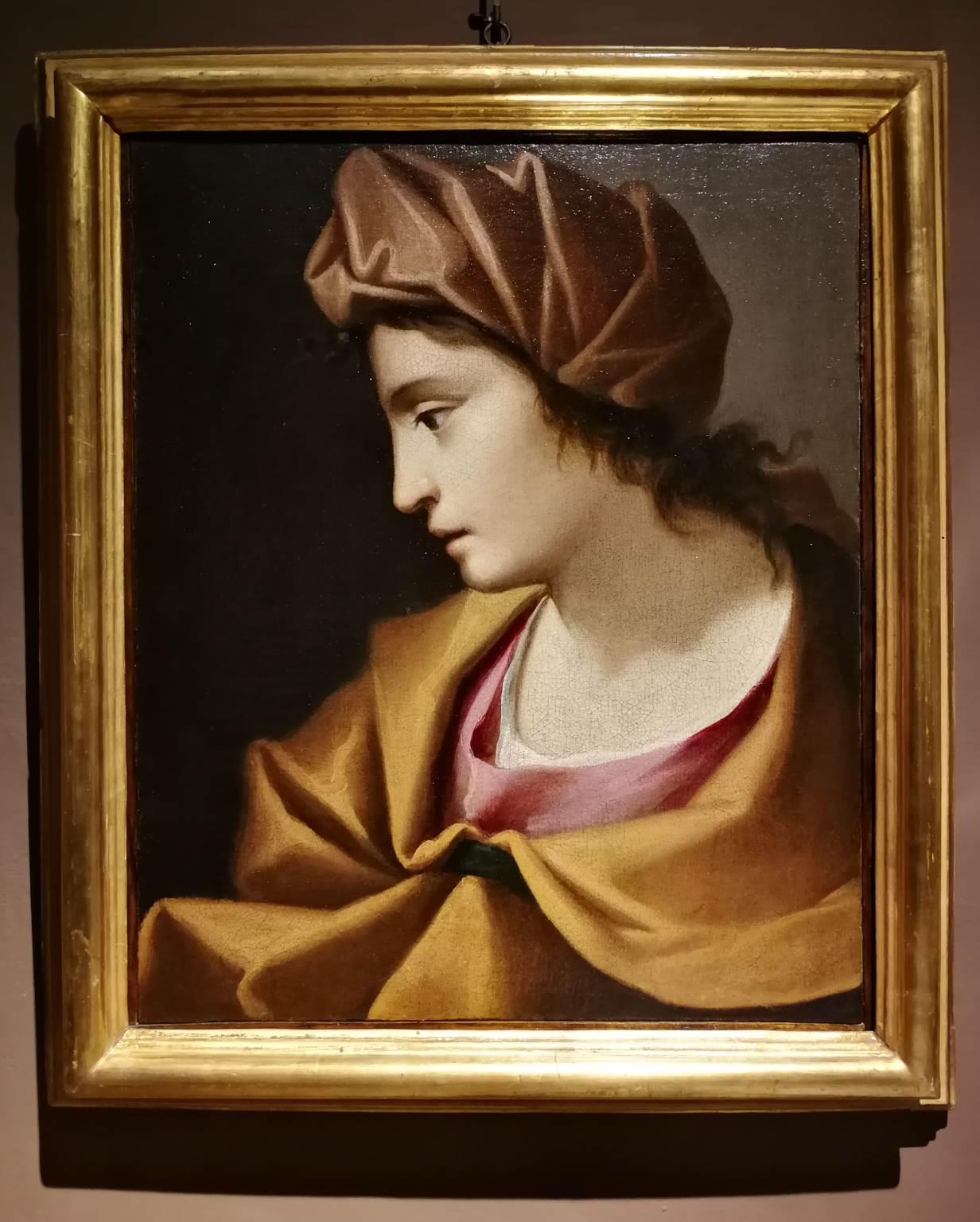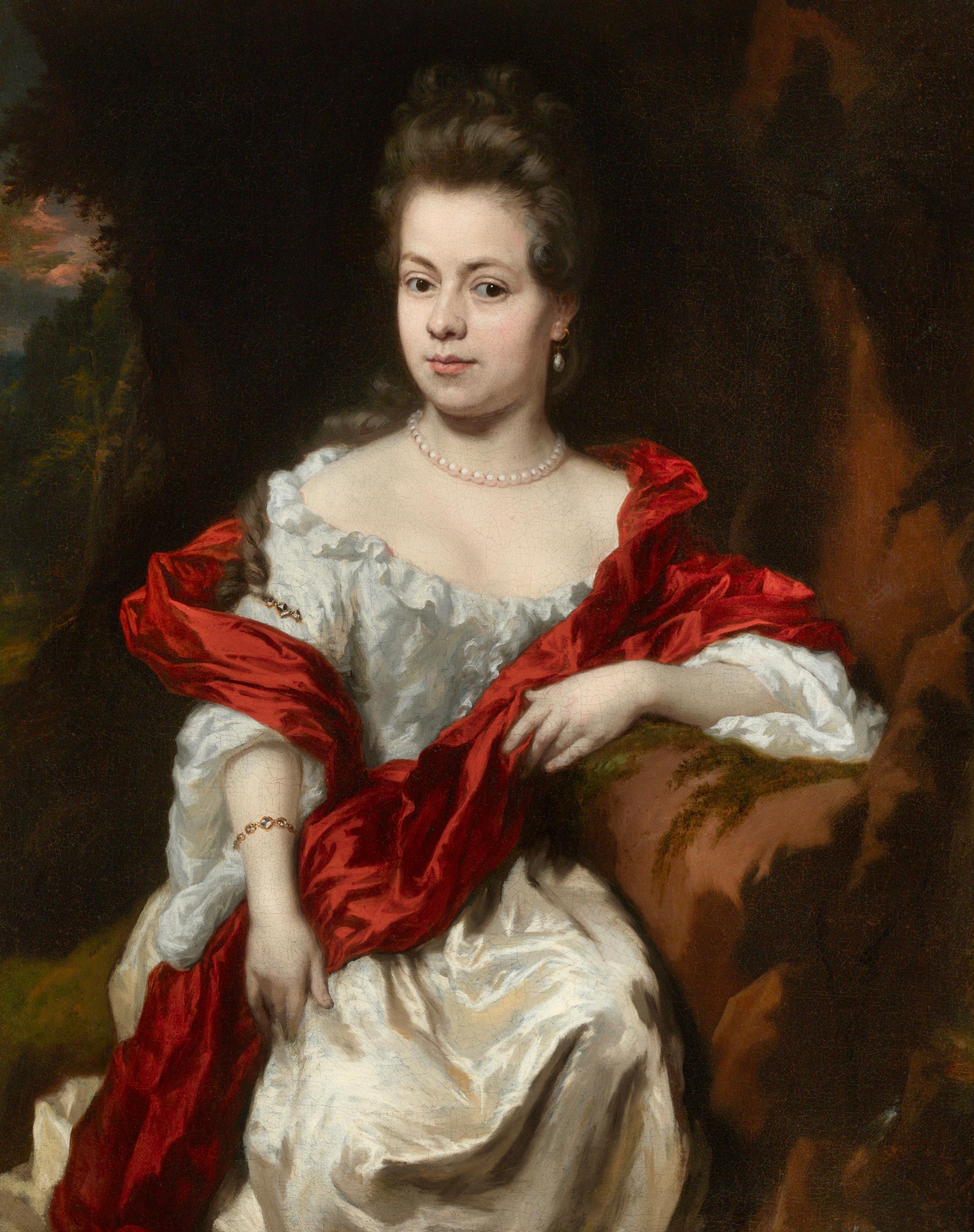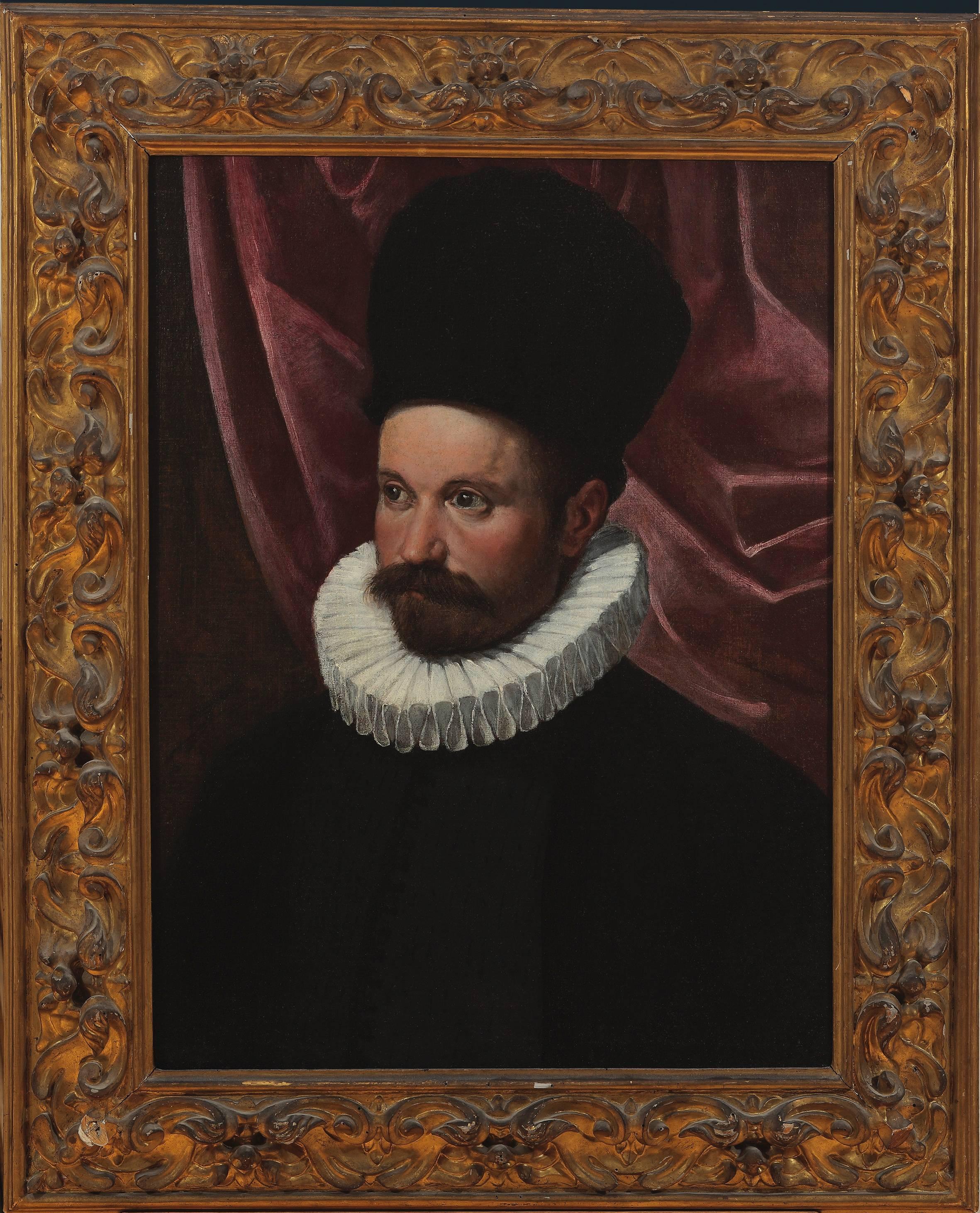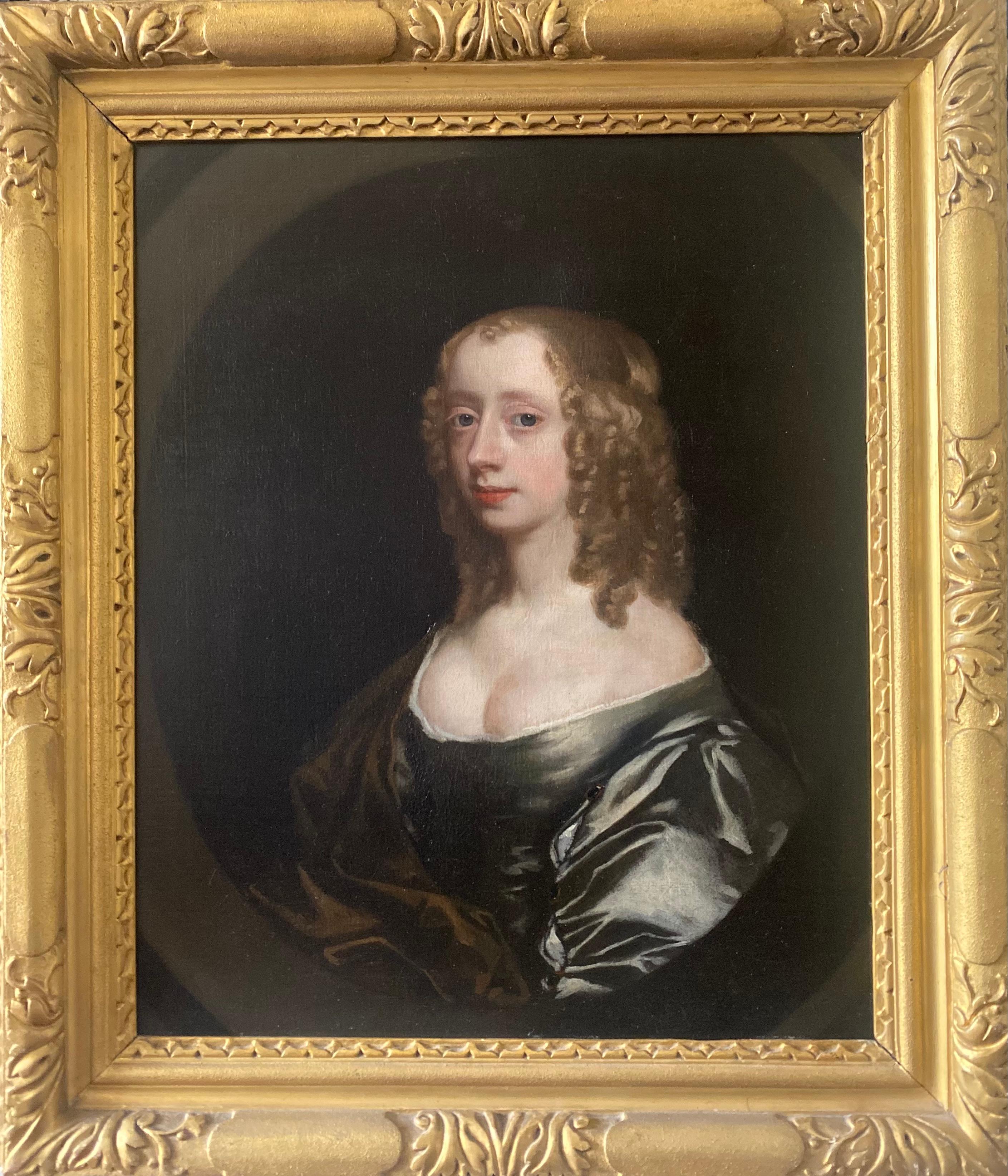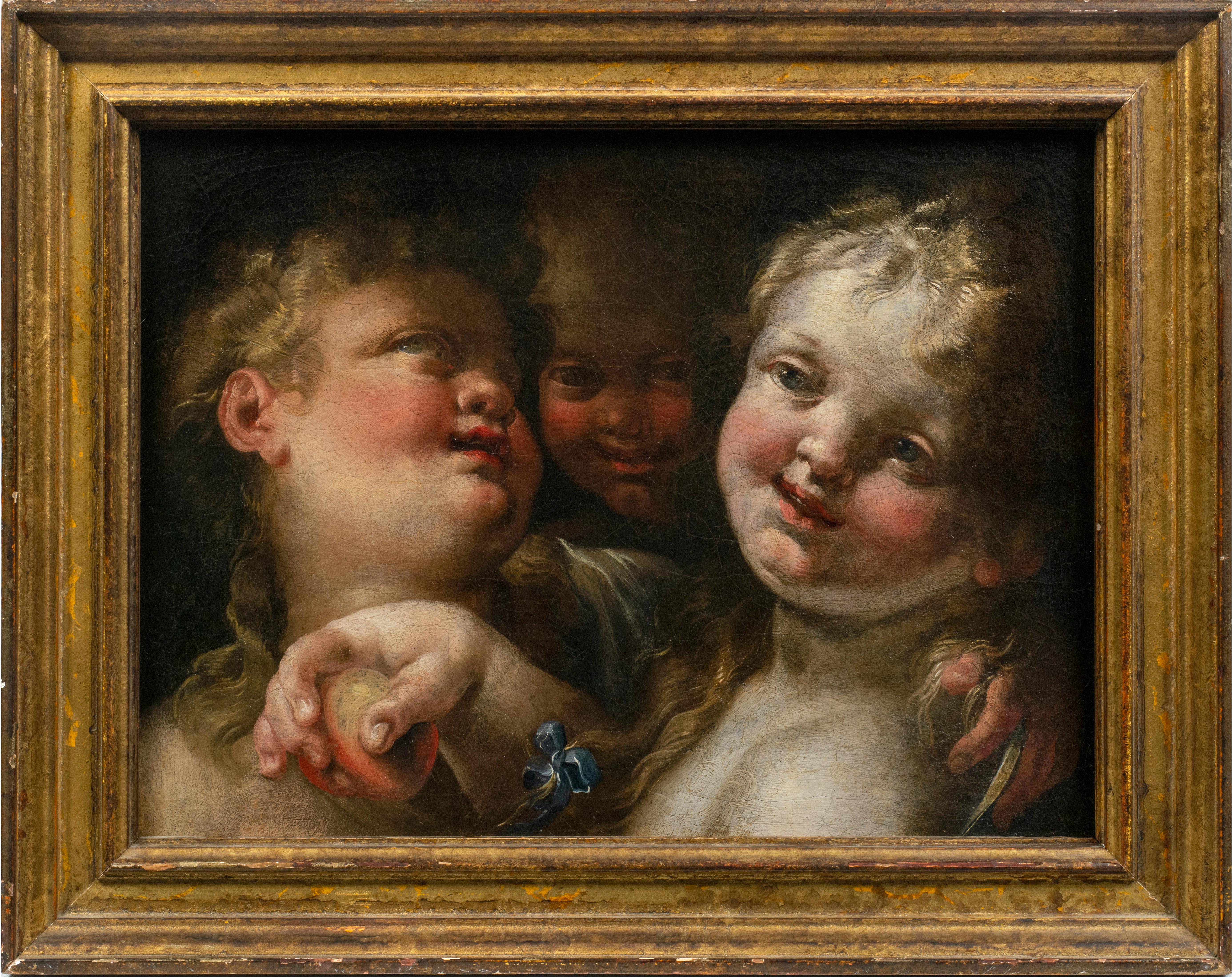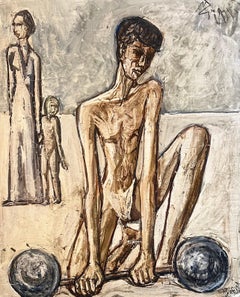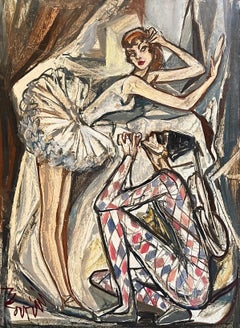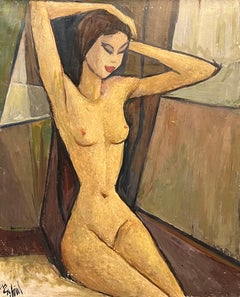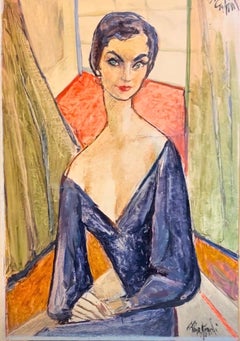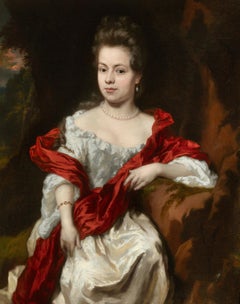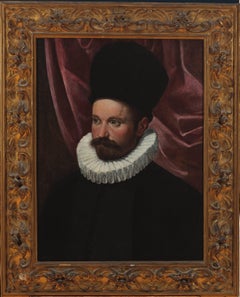Items Similar to Clown and Ballerina by Vivaldo Martini - Oil on canvas 50x61 cm
Video Loading
Want more images or videos?
Request additional images or videos from the seller
1 of 18
Vivaldo MartiniClown and Ballerina by Vivaldo Martini - Oil on canvas 50x61 cm
About the Item
His first name sounds like a concerto. Vivacious, its name is reminiscent of an aperitif or a cyclist. The addition of the two evokes the Italianate. Indomitable and unavoidable. Moreover, I was born on November 11, 1908 in Bellinzona, one day became a portrait painter of the president of the confederation, residing most of his life in Geneva, Vivaldo Martini refuses to leave his Italian nationality.
He has known ruptures in his life. But Italy has always remained the son of his soul. It's unwavering root. What is striking about this artist, both extraordinary and famous, is a way of dichotomy that has permeated a large slice of his existence. On the one hand, very strong in the art of capturing faces, and that from an early age, he became a beloved, sought-after portrait painter. On the other hand, he has not stopped following a more personal artistic path, two years after his death in May 1990, finally comes to light, and testifies that beyond the chronicler of his time, Vivaldo Martini was above all a great painter.
Artwork sold with frame (67.5 x 78.5 x 5 cm)
- Creator:Vivaldo Martini (1908 - 1989, Swiss, Italian)
- Dimensions:Height: 19.69 in (50 cm)Width: 24.02 in (61 cm)Depth: 0.79 in (2 cm)
- Medium:
- Movement & Style:
- Period:
- Condition:
- Gallery Location:Geneva, CH
- Reference Number:1stDibs: LU1434215465762
Vivaldo Martini
His first name sounds like a concerto. Vivacious, its name is reminiscent of an aperitif or a cyclist. The addition of the two evokes the Italianate. Indomitable and unavoidable. Moreover, I was born on November 11, 1908 in Bellinzona, one day became a portrait painter of the president of the confederation, residing most of his life in Geneva, Vivaldo Martini refuses to leave his Italian nationality. He has known ruptures in his life. But Italy has always remained the son of his soul. Its unwavering root. What is striking about this artist, both extraordinary and famous, is a way of dichotomy that has permeated a large slice of his existence. On the one hand, very strong in the art of capturing faces, and that from an early age, he became a beloved, sought-after portrait painter. On the other hand, he has not stopped following a more personal artistic path, two years after his death in May 1990, finally comes to light, and testifies that beyond the chronicler of his time, Vivaldo Martini was above all a great painter.
About the Seller
4.9
Platinum Seller
Premium sellers with a 4.7+ rating and 24-hour response times
Established in 2016
1stDibs seller since 2020
265 sales on 1stDibs
Typical response time: 1 hour
- ShippingRetrieving quote...Shipping from: Geneva, Switzerland
- Return Policy
Authenticity Guarantee
In the unlikely event there’s an issue with an item’s authenticity, contact us within 1 year for a full refund. DetailsMoney-Back Guarantee
If your item is not as described, is damaged in transit, or does not arrive, contact us within 7 days for a full refund. Details24-Hour Cancellation
You have a 24-hour grace period in which to reconsider your purchase, with no questions asked.Vetted Professional Sellers
Our world-class sellers must adhere to strict standards for service and quality, maintaining the integrity of our listings.Price-Match Guarantee
If you find that a seller listed the same item for a lower price elsewhere, we’ll match it.Trusted Global Delivery
Our best-in-class carrier network provides specialized shipping options worldwide, including custom delivery.More From This Seller
View AllWeightlifter by Vivaldo Martini - Oil on canvas 50x60 cm
By Vivaldo Martini
Located in Geneva, CH
His first name sounds like a concerto. Vivacious, its name is reminiscent of an aperitif or a cyclist. The addition of the two evokes the Italianate. Indomitable and unavoidable. Mor...
Category
Mid-20th Century Baroque Portrait Paintings
Materials
Canvas, Oil
Harlequin and Ballerina by Vivaldo Martini - Oil on canvas 55x41 cm
By Vivaldo Martini
Located in Geneva, CH
His first name sounds like a concerto. Vivacious, its name is reminiscent of an aperitif or a cyclist. The addition of the two evokes the Italianate. Indomitable and unavoidable. Mor...
Category
Mid-20th Century Baroque Portrait Paintings
Materials
Canvas, Oil
Brunette Nude Lady by Vivaldo Martini - Oil on canvas 65x54 cm
By Vivaldo Martini
Located in Geneva, CH
His first name sounds like a concerto. Vivacious, its name is reminiscent of an aperitif or a cyclist. The addition of the two evokes the Italianate. Indomitable and unavoidable. Mor...
Category
Mid-20th Century Baroque Portrait Paintings
Materials
Canvas, Oil
Woman Portrait by Vivaldo Martini - Oil on canvas 60x41 cm
By Vivaldo Martini
Located in Geneva, CH
His first name sounds like a concerto. Vivacious, its name is reminiscent of an aperitif or a cyclist. The addition of the two evokes the Italianate. Indomitable and unavoidable. Mor...
Category
Mid-20th Century Baroque Portrait Paintings
Materials
Canvas, Oil
Lady in Blue by Frank Chabry - Oil on canvas 46x55 cm
Located in Geneva, CH
Frank Chabry (1916-1979) was a 20th-century artist whose career spanned several transformative decades in the art world. His work likely reflects the arti...
Category
Mid-20th Century Baroque Abstract Paintings
Materials
Canvas, Oil
Self Portrait by Vivaldo Martini - Oil on Masonite 70.5x50 cm
By Vivaldo Martini
Located in Geneva, CH
His first name sounds like a concerto. Vivacious, its name is reminiscent of an aperitif or a cyclist. The addition of the two evokes the Italianate. Indomitable and unavoidable. Mor...
Category
Mid-20th Century Baroque Portrait Paintings
Materials
Oil, Masonite
You May Also Like
English 17th century portrait of John Ludford Esquire
By Mary Beale
Located in Bath, Somerset
Portrait of John Ludford (1653-1681), wearing a lace jabot and brown and gold trimmed cloak in a feigned stone oval cartouche. Inscribed 'John Ludford, Esq, nat. 14th March 1653, Ob,...
Category
Late 17th Century Baroque Portrait Paintings
Materials
Canvas, Oil
$11,949 Sale Price
20% Off
Dipinto ritratto femminile figurativo barocco emiliano del XVII secolo
By Girolamo Negri called Il Boccia
Located in Florence, IT
olio su tela, 62 x 51 cm (senza cornice)
Il dipinto è stato per lungo attribuito alla mano di Francesco Gessi, allievo di Guido Reni, come riporta un'iscrizione a matita datata 1945...
Category
Late 17th Century Baroque Figurative Paintings
Materials
Canvas, Oil
Portrait of Noble Lady
By Nicolaes Maes
Located in New Orleans, LA
Signed and dated "N MAE / 1691" (lower right)
Oil on canvas
A masterful example of 17th-century Dutch portraiture, this magnificent oil on canvas comes alive with luminous color, dramatic contrast and extraordinary detail. The work was composed by Nicolaes Maes, an artist widely regarded as the most prominent portrait painter of his era in Amsterdam. Fashionably styled, Portrait of a Noble Lady exemplifies the mature style of Maes, executed with the same artistry and attention to detail he imparted on his most important private commissions.
This work by Maes comes from the second half of his career and follows in the rich tradition of the great Flemish Baroque painters Peter Paul Rubens and Anthony van Dyck. Like these artists, Maes excels at not only capturing his subjects with a technical perfection but also their inherent elegance and grace. The sitter is draped in luxurious white and red silks and pearls, underscoring the importance and prosperity of his wealthy clientele. She is placed against a dark backdrop, enabling a striking chiaroscuro effect characteristic of the artist’s portraits.
Maes’s immense talent for detail and composition is clearly evident. In both palette and proportion, it embodies the somewhat austere style preferred by the artist, which emphasized a painstaking study of the costumes, hairstyles and accessories of his subjects. Such elaborate and highly detailed costuming in portraiture was a fashionable way to show one's wealth in the 17th century, particularly among the emerging class of wealthy merchants. Similar works by the painter can be found in the Rijksmuseum (Amsterdam), National Gallery (London), National Gallery of Art (Washington, D.C.), Metropolitan Museum of Art (New York) and Philadelphia Museum of Art, among others.
Nicolaes Maes was born in Dordrecht in 1634 to a prosperous cloth merchant. Around 1848, he moved to Amsterdam to study under Rembrandt for several years before returning to his native Dordrecht, where he established himself as a painter of genre scenes and portraits. In the 1650s, Maes traveled to Antwerp where he studied the work of Flemish artists such as Peter Paul Rubens, Anthony van Dyck and Jacob Jordaens...
Category
17th Century Baroque Portrait Paintings
Materials
Oil, Canvas
Portrait of a Gentleman
By Ippolito Scarsella (Scarsellino)
Located in New York, NY
Provenance: Suida-Manning Collection, New York
Private Collection
Exhibited: Venetian Paintings of the Sixteenth Century, Finch College Museum of Art, New York, October 30-December 15, 1963, no. 31.
Veronese & His Studio in North American Collections, Birmingham Museum of Art, Oct. 1-Nov. 15, 1972, and Montgomery Museum of Fine Arts, Dec. 5-Dec. 31, 1972
Literature: Robert L. Manning, A Loan Exhibition of Venetian Paintings of the Sixteenth Century, exh. cat. New York 1963, cat. no. 31ill., as by Veronese
Stephen Clayton and Edward Weeks, eds., introduction by David Rosand, Veronese & His Studio in North American Collections, Birmingham 1972, as by Veronese, p. 38 ill.
Terisio Pignatti, Veronese, Venice 1976, I, p. 199, cat. no. A225, II, fig. 908, as attributed to Veronese
Terisio Pignatti and Filippo Pedrocco, Veronese; catalogo completo dei dipinti, Florence 1991, no. 54°, as attributed to Veronese.
Terisio Pignatti and Filippo Pedrocco, Veronese, Milan 1995, II, pp. 517-518ill., cat. no. A 56, under attributed paintings, by Veronese and workshop)
John Garton, Grace and Grandeur; The Portraiture of Paolo Veronese, London-Turnhout 2008, p. 237, fig. 77, cat. no. R16, as workshop of Veronese.
Scarsellino’s art is widely regarded as critical link between the Renaissance and the Baroque styles in Emilian painting; not only was he an important transmitter of the heritage of the Renaissance, but he was also open to innovative ideas, and was one of the earliest to experiment with the trend to naturalism that would become fundamental to art of the new century. Born around 1550, he received his earliest training from his father Sigismondo, an architect and painter; it was probably while working at his father’s side as a youth that he acquired the nickname Scarsellino, or “little Scarsella”. After absorbing the principles of his art in Ferrara and Parma, he went to Venice in 1570, staying for four years and working in the shop of Veronese. In the following decade, his art —especially in terms of its piety and its development of landscape— demonstrates a strong sympathy with that of the Carracci, with whom he worked in 1592-1593 at the Palazzo dei Diamanti in Ferrara. Maria Angela Novelli and later Alessandra Frabetti both propose that Scarsellino traveled to Rome, although such a trip has not been documented; if he did travel to Rome, it probably would have occurred during the years that Scarsellino’s colleagues Agostino and Annibale Carracci were there, that is, beginning in 1595 and until 1609. The last decades of Scarsellino’s career again involve stylistic experimentation, this time in a manner that would bring his work very close to the progressive figurative naturalism of Carlo Bononi and prepare the way for Guercino.
The present portrait of a distinguished gentleman had been long thought to be by Paolo Veronese and was in fact attributed to him by such distinguished connoisseurs as Adolfo Venturi and Wilhelm Suida. The portrait’s style is, however, distinct from Veronese’s, although clearly indebted to it, and the attribution to the young Scarsellino is wholly convincing. The painting would then date from the 1570s – a date confirmed by the costume the subject wears. The puffed hat that appears in the painting had a rather short-lived vogue in the early 1570s. One sees it in Giambattista Moroni’s Portrait of Count...
Category
18th Century and Earlier Baroque Portrait Paintings
Materials
Canvas, Oil
English 17th century portrait of a lady
By Sir Peter Lely
Located in Bath, Somerset
A 17th century English portrait of a lady by Sir Peter Lely (1618-1680), half-length in a painted feigned oval, wearing a green silk gown with chestnut coloured cloak over one shoulder, her fair hair curled in the fashionable ringlet style of the period. Oil on canvas in an English giltwood 'Lely' frame.
We are grateful to Diana Dethloff and Catharine MacLeod (who are currently working on a Lely catalogue raisonné) for their confirmation of Lely as the artist from photograph analysis of this previously unidentified early work.
Provenance:
Private collection Nottingham until 2021
Mellors and Kirk sale December 2000, lot 1173
The sitter is likely to have been from an upper class or aristocratic family in court circles, who were the main source of Lely`s patronage. The simple composition serves to highlight the beauty of the sitter through portraying her pale decolletage and complexion, set against the gentle gaze of her blue eyes, the soft blush of her cheeks and her full red lips.
Peter Lely (1618-1680) was originally of dutch origin and became Principle Painter to the King in 1661, following in the footsteps of Van Dyck who had died in 1641. He dominated the portrait painting scene in England for over 20 years, creating a distinctive 'court look' in his work which had a strong influence on many other artists. He had an extremely successful and popular portrait practice which meant that he soon had to develop production methods that could accommodate the high demand for portraits, and also for copies and versions of them which were given as gifts to family and courtiers. The use of studio assistants was a common practice for busy artists and as with Van Dyck, Lely is known to have used specialist assistants to execute particular parts of his paintings. Artists who worked in Lely`s studio included John Baptist Gaspars who specialised in drapery painting, William Wissing, John Greenhill...
Category
17th Century Baroque Portrait Paintings
Materials
Oil, Canvas
$23,899 Sale Price
20% Off
Three Angels
By Domenico Piola the Elder
Located in New York, NY
Provenance:
Robert L. and Bertina Suida Manning, New York, until 1996
Private Collection, USA
One of the leading artists in Genoa during the second half of the seventeenth century, Domenico Piola came from a successful family of artists, renowned for their many illusionistic ceiling programs throughout Genoese churches and palaces. A prolific draughtsman and painter, Domenico oversaw an extremely productive studio. In addition to his collaborations with numerous other artists, Domenico also provided many designs for book illustrations and prints that circulated throughout Europe, earning him international exposure and high acclaim in his own day.
As Dr. Anna Orlando has indicated (written communication), the present work is an early work by Piola, datable from the late 1640s. At this time the young artist came strongly under the influence of Castiglione and Valerio Castello, while admiring the works of Giulio Cesare Procaccini. Piola’s works from this period are exuberant and fluid, and the artist’s love of portraying children is evident from the angels and putti that populate both his altarpieces and more intimate paintings.
The present work depicts three angels...
Category
17th Century Baroque Figurative Paintings
Materials
Oil, Canvas
Recently Viewed
View AllMore Ways To Browse
Two Clowns
Mid Century Clown
Large Clowns
Mid Century Ballerina
Martini Light
Italianate Frame
Oklahoma Photography
Pair Antique Oil Painting
Paris Street Scene Lithograph
Picasso Woodcut
R Scott
River Of No Return
Spanish Vintage Dress
Tokyo Poster
Vintage Linus
Cattle Photography
Chiens Painting
Dancing Underwater
